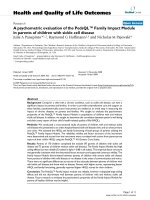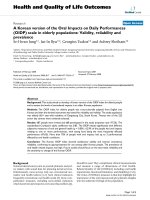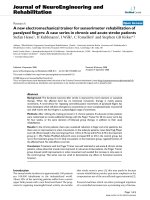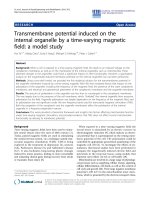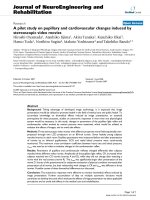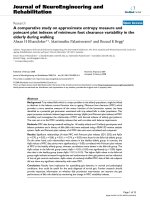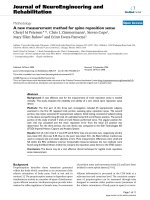Báo cáo hóa học: " A new construction on the q-Bernoulli polynomials" docx
Bạn đang xem bản rút gọn của tài liệu. Xem và tải ngay bản đầy đủ của tài liệu tại đây (204.79 KB, 6 trang )
RESEARC H Open Access
A new construction on the q-Bernoulli
polynomials
Seog-Hoon Rim
1*
, Abdelmejid Bayad
2
, Eun-Jung Moon
1
, Joung-Hee Jin
1
and Sun-Jung Lee
1
* Correspondence:
1
Department of Mathematics
Education, Kyungpook National
University Daegu 702-701, South
Korea
Full list of author information is
available at the end of the article
Abstract
This paper performs a further investigation on the q-Bernoulli polynomials and
numbers given by Açikgöz et al. (Adv. Differ. Equ. 2010, 9, Article ID 951764) some
incorrect properties are revised. It is pointed out that the definition concerning the
q-Bernoulli polynomials and numbers is unreasonable. The purpose of this paper is
to redefine the q-Bernoulli polynomials and numbers and correct its wrong
properties and rebuild its theorems.
1 Introduction/Preliminaries
Many mathematicians have studied the q-Bernoulli, q-Euler po lynomials and r elated
topics (see [1-11]). It is worth that Açikgöz et al. [1] give a new approach to the q-Ber-
noulli polynomials and the q-Bernstein polynomials and show some properties. That is,
Açikgöz et al. introduced a new generating function related the q-Bernoulli polyno-
mials and gave a new construction of these polynomials related to the second kind
Stirling numbers and the q-Bernstein polynomials in [1]. The purpose of this paper is
to redefine a generating function related the q-Bernoulli polynomials and numbers and
correct its wrong properties and rebuild its theorems.
In this paper, we assume that
q
(
∈ C
)
is indeterminate with |q| < 1. The q-number is
defined by
[x]
q
=
q
x
−1
q
−1
(see [4-9]).
It is known that the Bernoulli polynomials are defined as
t
e
t
− 1
e
xt
=
∞
n
=
0
B
n
(x)
t
n
n!
for |t| < 2
π
(1:1)
and that B
n
(0) = B
n
are called the Bernoulli numbers.
The recurrence formula for the classical Bernoulli numbers B
n
is as follows:
B
0
=1and
(
B +1
)
n
− B
n
=0 if n > 0
.
(1:2)
The q-extension of the following recurrence formula for the Bernoulli numbers is
given by
B
0,q
=1andq(qB +1)
n
− B
n,q
=
1ifn =1
0ifn >
1
(1:3)
with the usual convention of replacing
B
n
q
by B
n,q
(see [2,4]).
Rim et al. Advances in Difference Equations 2011, 2011:34
/>© 2011 Rim et al; l icensee Springer. This is an Open Access a rticle distributed under the terms of t he Creative Commons Attribution
License ( s/by/2.0), which permits u nrestricted use, distribution, and repr oduction in any medium,
provided the original work is properly cited.
2 On the q-Bernoulli polynomials and numbers
In this section, we first recall the q-Bernoul li polynomials and numbers, then indicate
the ambiguities on the Açikgöz et al. [1]’ s definition for the q-Bernoulli polynomials
and redefine it. Counter-examples show that some properties are incorrect. Specially,
these examples show that the concept on the generating function of the q-Bernoulli
polynomials is unreasonable.
Definition 2.1 (Açikgöz et al.[1])For
q
∈
C
with |q| < 1, let us define the q-Ber-
noulli polynomials as follows,
D
q
(t, x)=−t
∞
y
=0
q
y
e
[x+y]
q
t
=
∞
n=0
B
n,q
(x)
t
n
n!
.
(2:1)
Note that
lim
q→1
D
q
(t, x)=
t
e
t
− 1
e
xt
=
∞
n
=
0
B
n
(x)
t
n
n!
for |t| < 2π
,
(2:2)
where B
n
(x) are the classical Bernoulli polynomials.
In the special case x =0,B
n,q
(0) = B
n,q
are called the q-Bernoulli number.
That is,
D
q
(t)=D
q
(t,0)=−t
∞
y
=0
q
y
e
[y]
q
t
=
∞
n=0
B
n,q
t
n
n!
.
(2:3)
Remark 2.2 Definition 2.1 (Açikgöz et al. [1]) is unreasonable, since it is not the
generating functions of the q-Bernoulli polynomials and numbers. This can be seen
the following counter-examples.
Counter-example 2.3 If we take t = 0 in (2.2) of Definition 2.1 (Açikgöz et al. [1]),
then we have lim
q®1
D
q
(0, x)=0.But
lim
t→0
t
e
t
−1
e
xt
=
1
does not hol d in the sense of
Definition 2.1 (Açikgöz et al. [1]).
Counter-example 2.4 From (2.1) of Definition 2.1 (Açikgöz et al. [1]),
D
q
(t , x)=
∞
n=0
B
n,q
(x)
t
n
n!
= B
0,q
(x)+
∞
n
=1
B
n,q
(x)
t
n
n!
,
(2:4)
and
D
q
(t, x)=−t
∞
y=0
q
y
e
[x+y]
q
t
= −t
∞
y=0
q
y
∞
n=0
[x + y]
n
q
t
n
n!
=
∞
n=0
⎛
⎝
−
1
(1−q)
n
n
l=0
(
n
l
)(−1)
l
q
lx
∞
y=0
q
(l+1)y
⎞
⎠
t
n+1
n!
=
∞
n=0
−
n
(1−q)
n−1
n−1
l
=
0
(
n − 1
l
)(−1)
l
q
lx l
1−q
l+1
t
n
n!
.
(2:5)
Rim et al. Advances in Difference Equations 2011, 2011:34
/>Page 2 of 6
Comparing these identities (2.4) and (2.5), we obtain
B
0,q
(x)=0andB
n,q
(x)=−
n
(1 − q)
n−1
n−1
l=0
(
n − 1
l
)(−1)
l
q
lx
l
1 − q
l+1
.
(2:6)
This cannot satisfy some well-known results related the Bernoulli polynomials and
numbers. For example, B
0
=1.
Counter-example 2.5 From Definition 2.1 (Açikgöz et al. [1]), we note that
qD
q
(t ,1)− D
q
(t )=−t
∞
y=0
q
y+1
e
[1+y]
q
t
− t
∞
y=0
q
y
e
[y]
q
t
= t
,
(2:7)
and
qD
q
(t ,1)− D
q
(t )=q
∞
n=0
B
n,q
(1)
t
n
n!
−
∞
n=0
B
n,q
t
n
n!
=
∞
n
=
0
(qB
n,q
(1) − B
n,q
)
t
n
n!
.
(2:8)
From (2.7) and (2.8), we can easily derive that
B
n,q
=0andqB
n,q
(1) − B
n,q
=
1ifn =1
0ifn > 1
.
(2:9)
From (2.1) of Definition 2.1 (Açikgöz et al. [1]),
∞
n=0
B
n,q
(x)
t
n
n!
= D
q
(t , x)
= −t
∞
y=0
q
y
e
[x+y]
q
t
= e
[x]
q
t
1
q
x
D
q
(tq
x
)
=
∞
l=0
[x]
l
q
t
l
l!
×
∞
m=0
B
m,q
q
(m−1)x
t
m
m!
=
∞
n=0
n
m=0
(
n
m
)B
m,q
q
(m−1)x
[x]
n−m
q
t
n
n!
.
(2:10)
If we compare the coefficients on the both sides in (2.10),
B
n,q
(x)=
n
m=0
(
n
m
)B
m,q
q
(m−1)x
[x]
n−m
q
.
(2:11)
From (2.9) and (2.11),
B
0,q
(x)=
1
q
x
B
0,q
=0
.
(2:12)
However, these are also incorrect.
Next, we redefine the q-Bernoulli polynomials and numbers.
Rim et al. Advances in Difference Equations 2011, 2011:34
/>Page 3 of 6
Definition 2.6 For
q
∈
C
with |q| < 1, let us define the q-Bernoulli polynomials B
n,q
(x) as follows,
F
q
(t , x)=
q − 1
logq
e
1
1−q
t
− t
∞
m
=
0
q
x+m
e
[x+m]
q
t
=
∞
n
=
0
B
n,q
(x)
t
n
n!
.
(2:13)
Note that
lim
q→1
F
q
(t , x)=
t
e
t
− 1
e
xt
=
∞
n
=
0
B
n
(x)
t
n
n!
for |t| < 2π
,
(2:14)
where B
n
(x) are the classical Bernoulli polynomials.
In the special case x =0,B
n,q
(0) = B
n,q
are called the q-Bernoulli numbers. That is,
F
q
(t )=F
q
(t ,0)=
∞
n
=
0
B
n,q
t
n
n!
.
(2:15)
By simple calculations, we get
∞
n=0
B
n,q
(x)
t
n
n!
= F
q
(t , x)
= e
[x]
q
t
F
q
(q
x
t)
=
∞
m=0
[x]
m
q
t
m
m!
×
∞
l=0
B
l,q
q
lx
t
l
l!
=
∞
n=0
n
l
=
0
(
n
l
)B
l,q
q
lx
[x]
n−l
q
t
n
n!
.
(2:16)
Comparing the coefficients on the both sides in (2.16), we obtain
B
n,q
(x)=
n
l=0
(
n
l
)B
l,q
q
lx
[x]
n−l
q
.
(2:17)
From (2.13) and (2.15), we derive the following equation.
B
0,q
=
q − 1
logq
and B
n,q
(1) − B
n,q
=
1ifn =1
0ifn > 1
.
(2:18)
By (2.17) and (2.18), we can see that
B
0,q
=
q − 1
logq
and
n
l
=
0
(
n
l
)B
l,q
q
l
− B
n,q
=
1ifn =1
0ifn > 1
.
(2:19)
Theorem 2.7* For n Î N*, we have
B
0,q
=
q − 1
logq
and (qB
q
+1)
n
− B
n,q
=
1ifn =1
0ifn > 1
.
(2:20)
with the usual convention of replacing
B
n
q
by B
n,q
.
Remark 2.8 Theorem 2.7* is a revised theorem of Theorem 2.1 in [1].
Rim et al. Advances in Difference Equations 2011, 2011:34
/>Page 4 of 6
From (2. 13), we have
∞
n=0
B
n,q
(x)
t
n
n!
= F
q
(t , x)
=
q − 1
logq
e
1
1−q
t
− t
∞
m=0
q
x+m
e
[x+m]
q
t
=
q − 1
logq
∞
n=0
1
(1 − q)
n
t
n
n!
−
∞
m=0
q
x+m
∞
n=0
n[x + m]
n−1
q
t
n
n!
=
∞
n=0
q−1
logq
1
(1−q)
n
− n
∞
m=0
q
x+m
[x + m]
n−1
q
t
n
n!
=
∞
n=0
−
(1−q)
n
logq
−
n
(1−q)
n−1
∞
m=0
q
x+m
n−1
l=0
(
n − 1
l
)(−1)
l
q
(x+m)l
t
n
n!
=
∞
n=0
(q−1)
1−n
logq
+
n
(1−q)
n−1
n−1
l=0
(
n − 1
l
)(−1)
l+1
q
(l+1)x
1
1−q
(l+1)
t
n
n!
=
∞
n=0
1
(1−q)
n
n
l
=
0
(
n
l
)(−1)
l
q
lx
l
[l]
q
t
n
n!
.
(2:21)
By (2.21), we obtain the following theorem.
Theorem 2.9* For n Î N*, we have
B
0,q
=
q − 1
logq
and B
n,q
(x)=
1
(1 − q)
n
n
l=0
(
n
l
)(−1)
l
q
lx
l
[l]
q
.
(2:22)
Remark 2.10 Theorem 2.9* is a revised theorem of Theorem 2.3 in [1].
Acknowledgements
The authors would like to thank the anonymous referee for his/her excellent detail comments and suggestions.
This research was supported by Kyungpook National Universi ty Research Fund, 2010.
Author details
1
Department of Mathematics Education, Kyungpook National University Daegu 702-701, South Korea
2
Département de
mathématiques, Université Evry Val d’Essonne, Bd. F1. Mitterrand, 91025 Evry Cedex, France
Authors’ contributions
Coresponding author raised the problem and make a sequence to appoach the problem. AB carried out the q-
Bernoulli poynomials studies, participated in the making new construction of the q-Bernoulli numbers. EJM carried out
the calculation of [1]. JHJ participated in the sequence alignment. SJL performed the correction problem. All authors
read and approved the final manuscript.
Competing interests
The authors declare that they have no competing interests.
Received: 24 February 2011 Accepted: 18 September 2011 Published: 18 September 2011
References
1. Açikgöz, M, Erdal, D, Araci, S: A new approach to q-Bernoulli numbers and q-Bernoulli polynomials related to q-
Bernstein polynomials. Adv Differ Equ 9 (2010). Article ID 951764
2. Carlitz, L: q-Bernoulli numbers and polynomials. Duke Math J. 15, 987–1000 (1948). doi:10.1215/S0012-7094-48-01588-9
3. Kac, V, Cheung, P: Quantum Calculus, Universitext. Springer, New York (2001)
4. Kim, T: A new approach to q-zeta function. Adv Stud Contemp Math. 11(2), 157–162 (2005)
5. Kim, T: q-Volkenborn integration. Russ. J Math Phys. 9(3), 288–299 (2002)
6. Kim, T: On p-adic q-L-functions and sums of powers. Discret Math. 252(1-3), 179–187 (2002). doi:10.1016/S0012-365X(01)
00293-X
7. Kim, T: q-Bernoulli numbers and polynomials associated with Gaussian binomial coefficients. Russ J Math Phys. 15(1),
51–57 (2008)
Rim et al. Advances in Difference Equations 2011, 2011:34
/>Page 5 of 6
8. Kim, T: Power series and asymptotic series associated with the q-analog of the two-variable p-adic L-function. Russ J
Math Phys. 12(2), 186–196 (2005)
9. Kim, T: Analytic continuation of multiple q-zeta functions and their values at negative integers. Russ J Math Phys. 11(1),
71–76 (2004)
10. Kim, T: On explicit formulas of p-adic q-L-functions. Kyushu J Math. 48(1), 73–86 (1994). doi:10.2206/kyushujm.48.73
11. Kim, T, Kim, HS: Remark on p-adic q-Bernoulli numbers, Algebraic number theory (Hapcheon/Saga, 1996). Adv Stud
Contemp Math Pusan. 1, 127–136 (1999)
doi:10.1186/1687-1847-2011-34
Cite this article as: Rim et al.: A new construction on the q-Bernoulli polynomials. Advances in Difference Equations
2011 2011:34.
Submit your manuscript to a
journal and benefi t from:
7 Convenient online submission
7 Rigorous peer review
7 Immediate publication on acceptance
7 Open access: articles freely available online
7 High visibility within the fi eld
7 Retaining the copyright to your article
Submit your next manuscript at 7 springeropen.com
Rim et al. Advances in Difference Equations 2011, 2011:34
/>Page 6 of 6


